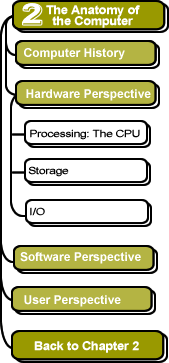

|
How Does the Storage Hierarchy Work?
The storage hierarchy works by using a tradeoff between speed and size:
- Large (but slow) memory lies at the bottom of the hierarchy
- Small (but fast) memory lies at the top
- The fastest memory available is quite expensive, so a cost-effective computer system must use it sparingly.
- Although hard drives can hold huge amounts of information, they are mechanical devices and thus significantly slower than memory that is completely electronic, with no moving parts.
-
Main memory (sometimes called RAM) is slower than cache memory but less expensive per byte.
- Each element in the hierarchy is faster but smaller than the element below it.

Typical speeds
and sizes for the different levels of the memory hierarchy are show below.
Note that the speed is given in nanoseconds (one billionths of a second),
so a smaller number is better (faster). Also note that the hard drive,
being a mechanical device with moving parts, is much slower than
the next level above, so when the CPU is forced to go all the way to the
bottom of the hierarchy, it is a very large speed penalty indeed!
| Level | Typical Size (bytes) | Typical Speed (nanoseconds) |
|---|---|---|
| Registers |
128
|
1
|
| Cache |
262144
|
10
|
| Main Memory |
134217728
|
50
|
| Hard Drive |
21474836480
|
1000000000 |
![]()
![]()
These pages were written by Steven H. VanderLeest and Jeffrey Nyhoff and edited by Nancy Zylstra
©2005 Calvin University (formerly Calvin College), All Rights Reserved
If you encounter technical errors, contact computing@calvin.edu.